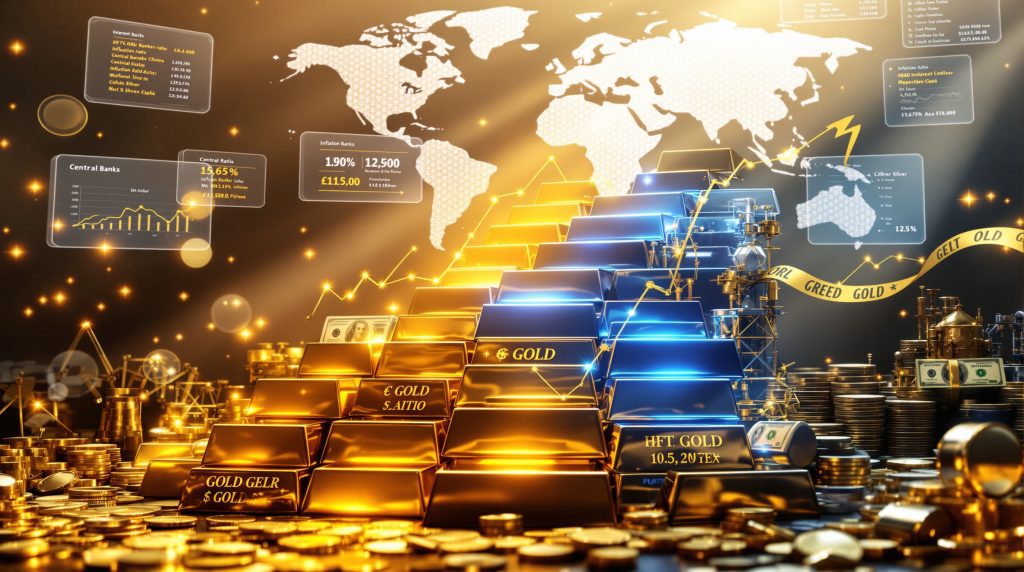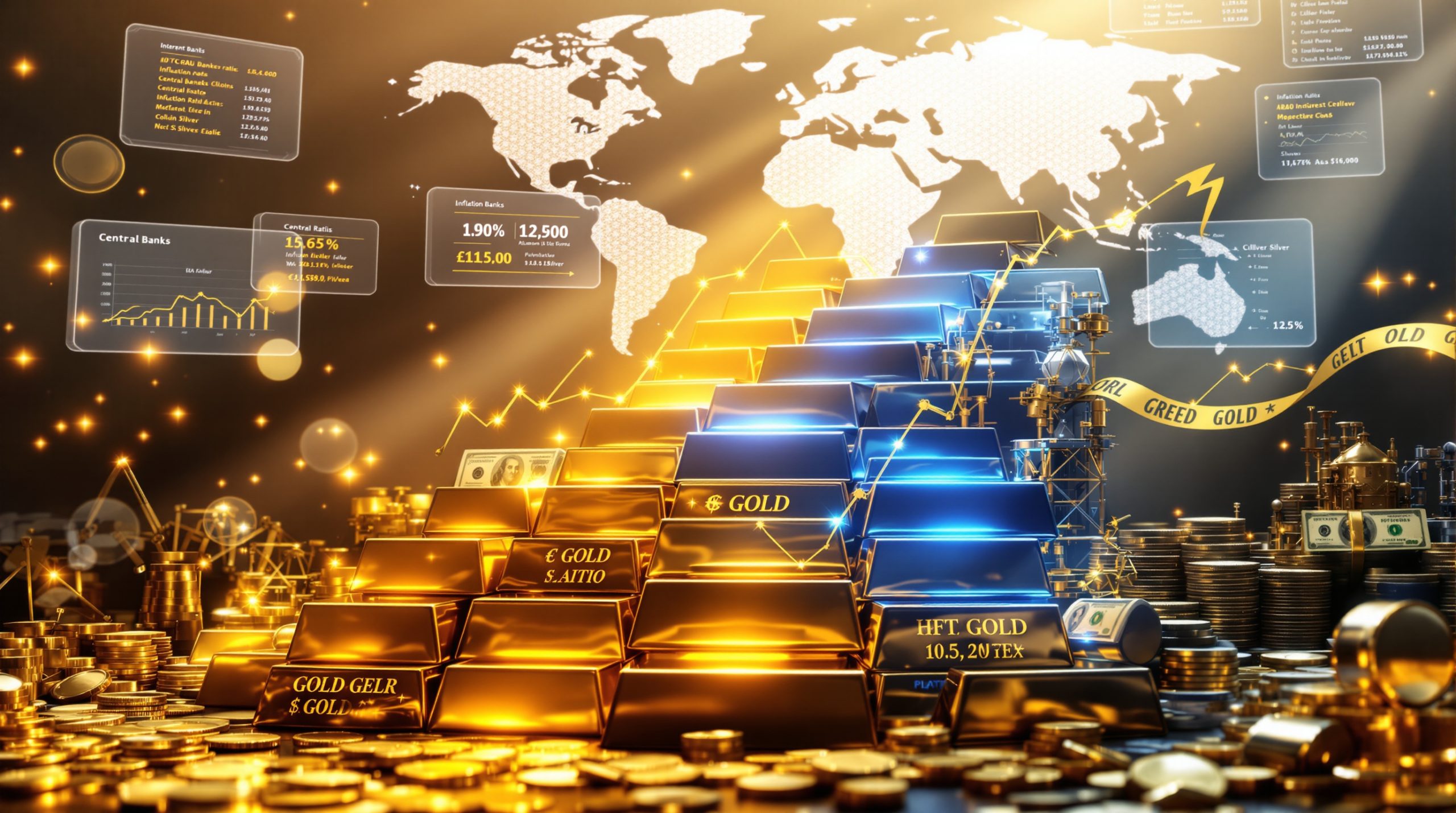What Factors Drive Gold and Silver Price Movements?
The precious metals market is influenced by a complex interplay of economic, geopolitical, and market-specific factors that create both gradual trends and sudden price swings. Understanding these drivers helps investors anticipate potential gold prices analysis and make more informed decisions in this dynamic market sector.
How Do Macroeconomic Conditions Impact Precious Metals Prices?
Interest Rate Dynamics and Central Bank Policies
Interest rates fundamentally impact precious metals prices through opportunity cost mechanics. When central banks lower interest rates, the opportunity cost of holding non-yielding assets like gold and silver decreases, making them more attractive investments. Conversely, rising rates typically create downward pressure on precious metals as yield-bearing assets become more competitive.
According to the World Gold Council, gold typically shows strong inverse correlation with real interest rates (nominal rates minus inflation). This relationship has been particularly evident in recent market activity, with gold reaching new highs as the Federal Reserve signaled a shift toward a rate-cutting cycle.
Inflation and Currency Devaluation Concerns
Precious metals, particularly gold, have served as traditional hedges against inflation and currency devaluation for centuries. When investors anticipate rising inflation or declining currency values, they often increase their precious metals allocations to preserve purchasing power.
The current environment features persistent inflation that has remained above the Federal Reserve's 2% target for an extended period. The latest data from the Bureau of Labor Statistics shows U.S. inflation at 2.4% year-over-year as of September 2024. This environment has strengthened the inflation-hedge narrative for gold and silver, especially as real returns on cash and fixed-income investments have turned negative when adjusted for inflation.
Economic Growth and Employment Indicators
Employment data and economic growth metrics significantly influence precious metals markets. Weaker-than-expected economic data often triggers safe-haven buying, while strong economic performance can reduce demand for defensive assets.
Recent employment reports have shown significant downward revisions, with labor market conditions cooling more than initially reported. These indicators have reinforced concerns about economic stability, contributing to the rally in precious metals prices as investors seek portfolio protection against potential slowdowns.
What Market-Specific Factors Drive Gold and Silver Prices?
Supply and Demand Fundamentals
Physical supply and demand dynamics create the foundation for price movements in precious metals:
Gold Supply Factors:
- Annual mining production (approximately 3,000 tonnes globally)
- Central bank sales or purchases
- Recycling of existing gold
- Above-ground stockpiles (approximately 208,874 tonnes according to World Gold Council)
Silver Supply Factors:
- Primary silver mining (approximately 30% of supply)
- By-product production from base metal mining (70% of supply)
- Recycling streams
- Industrial consumption patterns
Recent trends show unprecedented physical demand across both institutional and retail channels. The U.S. imported approximately $9.6 billion worth of non-monetary gold in July 2024 alone, according to trade data, representing a significant shift in traditional gold flow patterns.
Central Bank Purchasing Patterns
Central bank gold milestone buying has emerged as a major driver of gold prices in recent years. Official sector purchases have reached record levels, with many nations diversifying reserves away from traditional currencies.
According to the World Gold Council, central banks purchased 1,037 tonnes of gold in 2023, marking one of the strongest years on record. This trend has continued into 2024, with emerging market central banks leading acquisitions as part of a broader strategy to reduce exposure to dollar-denominated assets.
Investment Demand Shifts
Investment demand through various vehicles significantly impacts precious metals prices:
ETF Flows: Exchange-traded funds provide easy exposure to precious metals prices. Inflows and outflows from major funds like SPDR Gold Trust (GLD) and iShares Silver Trust (SLV) can amplify price movements.
Physical Bullion Demand: Retail and institutional demand for physical metals creates direct market pressure. Recent market reports indicate a sharp increase in retail precious metals transactions, suggesting broader market participation beyond institutional investors.
Institutional Allocation Changes: Major shifts in recommended portfolio allocations from financial institutions can trigger substantial price movements. Several large financial institutions have recently suggested increasing gold allocations from traditional 5% levels to significantly higher percentages, reflecting changing risk perceptions.
How Do Geopolitical Factors Influence Precious Metals Prices?
Global Tensions and Uncertainty
Geopolitical crises and tensions typically boost precious metals prices as investors seek safe-haven assets during periods of uncertainty. Current global flashpoints include:
- Ongoing conflicts in Ukraine and the Middle East
- Trade tensions between major economies
- Political transitions and elections in key nations
- Concerns about financial system stability
These factors contribute to market volatility and often drive investors toward perceived safe havens like precious metals during periods of heightened uncertainty.
De-Dollarization Trends
The gradual shift away from dollar dominance in international trade and reserves has supported precious metals prices. Several developments highlight this trend:
- BRICS nations establishing alternative payment systems
- Growth of the Shanghai Gold Exchange and its gold-backed settlement options
- Increasing bilateral currency agreements that bypass the dollar
- Development of the M-Bridge technology for cross-border settlements
M-Bridge is a real-world initiative by the central banks of China, Thailand, UAE, and Hong Kong for facilitating cross-border payments without relying on traditional dollar-based systems. These alternatives create additional demand channels for precious metals as countries seek to diversify their reserve assets.
Regulatory and Policy Developments
Policy decisions can significantly impact precious metals markets:
- The recent classification of silver as a critical mineral by the U.S. government establishes potential support levels and acknowledges its strategic importance
- Changes to mining regulations in key producing countries
- Evolving ESG requirements affecting mining operations and production costs
- Trade policies affecting cross-border movement of precious metals
The U.S. Geological Survey's inclusion of silver on the Critical Materials List in 2024 represents a significant policy shift with potential implications for market dynamics and pricing.
Why Does Silver Often Outperform Gold During Bull Markets?
The Gold-Silver Ratio Dynamics
The gold-silver ratio (the price of gold divided by the price of silver) provides insights into relative value and potential performance. Historically, this ratio contracts during precious metals bull markets as silver outperforms.
The historical average gold-silver ratio hovers around 60:1, but recent values have been significantly higher, approximately 78-82:1 as of October 2024. This elevated ratio suggests potential for silver outperformance if historical patterns repeat, as the ratio typically contracts during strong precious metals bull markets.
During the 1979-1980 precious metals bull market, silver rose from $6 to $50 (a 733% gain) while gold rose from $200 to $850 (a 325% gain), demonstrating silver's characteristic of outperforming gold during strong bull markets. For more detailed insights, the gold-silver ratio insights provide valuable context for investors.
Industrial Demand Factors
Unlike gold, silver has substantial industrial applications that create additional demand drivers:
- Electronics and electrical contacts
- Photovoltaic (solar) panels (consuming approximately 100-130 million ounces annually)
- Electric vehicle components (requiring 1-2 ounces per vehicle)
- Medical applications and antimicrobial uses
- Water purification systems
This industrial demand provides an additional catalyst during periods of economic growth or technological advancement, potentially giving silver greater upside during certain market conditions. The Silver Institute estimates industrial demand accounts for approximately 50% of annual silver consumption.
Supply Constraints
Silver faces more significant supply constraints than gold:
- Most silver production comes as a by-product of other metal mining
- Above-ground inventories have declined significantly
- Industrial consumption often doesn't return to the recycling stream
- Physical delivery demands have strained exchange inventories
These supply dynamics, combined with increasing industrial applications in emerging technologies, create a unique market structure that can lead to amplified price movements when demand increases.
What Technical Factors Influence Precious Metals Price Movements?
Momentum and Trend Following
Technical momentum plays a crucial role in precious metals price movements. Momentum indicators and trend-following systems often drive institutional trading strategies in these markets, amplifying price movements once key levels are breached.
Technical gold analysis reveals potentially significant chart patterns forming over multi-decade timeframes. Some analysts have identified a 45-year cup-and-handle formation in silver, a pattern typically associated with potential breakouts above previous resistance levels.
Key Price Levels and Psychological Barriers
Significant psychological price levels often create temporary resistance or support:
- Gold's previous all-time highs around $2,000-2,100
- Silver's historical high near $50 from 1980 and 2011
- Round numbers that attract options interest and trigger technical trading
These psychological levels often require multiple attempts before being decisively breached, creating consolidation zones that can last for extended periods.
Market Positioning and Sentiment
The positioning of speculative traders and commercial hedgers provides insights into potential price movements:
- Extreme positioning in either direction often precedes reversals
- Commercial hedger positions reflect industry expectations
- Retail sentiment indicators can signal contrarian opportunities
The CFTC's Commitment of Traders reports provide valuable data on positioning across different market participant categories, offering clues about potential market turning points.
How Should Investors Approach Gold and Silver in the Current Environment?
Portfolio Allocation Considerations
Financial advisors traditionally recommended modest precious metals allocations (typically around 5%), but this guidance is evolving. Several major financial institutions have recently suggested higher allocations to precious metals as portfolio protection against inflation, currency devaluation, and systemic risks.
Academic studies on optimal asset allocation suggest that even modest precious metals exposure (5-10%) can significantly reduce portfolio volatility while maintaining similar returns over long timeframes. The current economic environment has led some analysts to recommend even higher allocations based on specific risk factors in today's markets.
Physical vs. Paper Exposure
Investors must decide between physical ownership and financial exposure:
Physical Ownership Benefits:
- No counterparty risk
- Direct possession and control
- Privacy considerations
- Potential premium appreciation for certain products
Financial Exposure Benefits:
- Liquidity and ease of trading
- No storage or insurance costs
- Potential leverage opportunities
- Tax reporting simplicity
During the 2008 financial crisis, physical precious metals maintained value while some ETFs experienced temporary dislocations due to liquidity constraints. This historical precedent highlights the different risk profiles of physical versus paper metal investments.
Timing Considerations
While timing markets perfectly is impossible, several factors suggest continued strength in precious metals:
- Persistent inflation above target levels
- Central bank policy shifts toward accommodation
- Ongoing physical demand from institutional buyers
- Technical breakouts above long-term resistance levels
- Relative value compared to traditional financial assets
For investors new to precious metals, dollar-cost averaging can provide a disciplined approach to building positions without attempting to time exact market tops or bottoms. Developing effective gold investment strategies is crucial for navigating market cycles.
Considerations for New Precious Metals Investors
Understanding Product Categories
New precious metals investors should familiarize themselves with the various product categories:
- Bullion coins (American Eagles, Canadian Maples, etc.)
- Sovereign coins (older circulation coins with gold/silver content)
- Private mint bars and rounds
- Numismatic and semi-numismatic products
Each category offers different advantages regarding liquidity, premium over spot, collector value, and recognition. New investors typically benefit from focusing on widely recognized bullion products with lower premiums before exploring more specialized offerings.
Storage and Security Planning
Secure storage represents a critical consideration for physical precious metals:
- Home storage options (safes, concealment systems)
- Bank safe deposit boxes (convenient but with limitations)
- Private vault facilities (specialized security, often with insurance)
- Allocated storage programs through dealers
Investors should carefully consider security, accessibility, privacy, and jurisdiction when developing their storage strategy, with many experts recommending diversification across multiple storage methods.
Tax Implications and Reporting Requirements
Precious metals investors must understand relevant tax implications:
- Long-term capital gains treatment for investment metals
- Collectible tax rate (currently 28% maximum) versus standard capital gains rates
- Dealer reporting requirements for certain transaction types and sizes
- International reporting considerations for offshore storage
Consulting with tax professionals familiar with precious metals investments can help investors develop tax-efficient acquisition and liquidation strategies. For additional information, economic trends affecting precious metals can provide valuable context for tax planning.
Conclusion
The price movements of gold and silver reflect a complex interplay of macroeconomic conditions, market-specific factors, geopolitical developments, and technical considerations. Current trends suggest a fundamental shift in how major market participants view these metals, with unprecedented physical demand, changing institutional allocation recommendations, and technical breakouts potentially signaling a new phase in the precious metals market.
For investors, understanding these driving factors provides context for portfolio decisions and helps distinguish between short-term noise and meaningful long-term trends. As the monetary and financial landscape continues to evolve, precious metals appear positioned to play an increasingly important role in investment portfolios and the broader financial system. Those interested in understanding the various factors that affect gold and silver prices should also explore the detailed analysis from Investopedia for further insights.
Disclaimer: This article provides information and analysis about precious metals markets but does not constitute investment advice. All investments involve risk, and past performance is no guarantee of future results. Readers should conduct their own research and consult with financial advisors before making investment decisions.
Ready to Stay Ahead of Major Market Discoveries?
Discover market-moving ASX mineral announcements as they happen with Discovery Alert's proprietary Discovery IQ model, turning complex market data into actionable investment insights. Explore why major mineral discoveries can lead to significant market returns by visiting Discovery Alert's dedicated discoveries page and begin your 30-day free trial today.




